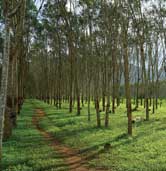A greater commitment to sustainability in the production and supply chain of natural rubber will help the global industry bounce back better after the devastating impact of the coronavirus pandemic, according to PEFC (Programme for the Endorsement of Forest Certification).
If (sustainability commitment) grows in line with the Sustainable Development Goals, it will have even more impact in the Asia Pacific region for many more years to come, it adds.
Despite the size of the industry and the complexity of the supply chain, the sources of natural rubber are quite modest and largely concentrated in Southeast Asia.
What’s more, 85% is produced by six million smallholders, tapping and tending rubber trees on independent plantations. Significantly, most of these plantations are in Thailand, Vietnam, Indonesia and Malaysia.
As PEFC readies to launch its global Supporting Sustainable Rubber campaign in July, the organisation was also involved in two major international rubber events, namely, a webinar organised on the eve of World Environment Day (5 June) by the Network for Certification and Conservation of Forests (NCCF) for the Rubber Board, Ministry of Commerce, and Industry, Government of India on Long Term Sustainability of the Resource and Rubber Industry in India.
As well, the International Rubber Study Group (IRSG), in collaboration with the Ministry of Agriculture and Rural Development of the Government of Cote d’Ivoire, organised the virtual World Rubber Summit (WRS) 2021 on 10 June with the theme, ‘’Facing the Future: Inclusiveness, Sustainability and Growth for the Next Normal’’.
What was learnt from these events is that natural rubber is an essential raw material used in the creation of more than 40,000 products and representing US$300 billion supply chain involving 40 million people (IRSG, 2019).
There’s more to learn: 47% of the global rubber supply is natural, derived from about 14 million hectares of plantations around the world. In 2018, the total value of that rubber was US$40.71 billion. In 2019, natural rubber production reached 13.6 million metric tonnes. 70% of natural rubber goes into tyre production. Rubber plantations produce more than rubber! About 63 million green tonnes of rubber wood are produced annually. Rubber wood is the world’s most widely traded tropical hardwood (ITTO, 2017).
A member of both the IRSG and GPSNR ( Global Platform for Sustainable Natural Rubber), PEFC has been advocating the rights of smallholders and forest operators in Southeast Asia for 20 years now. As it has provided chain of custody certification for products originally sourced from forests, like furniture, flooring, paper and packaging, it is also doing the same for natural rubber and rubber wood, whether its end use is for rubber tyres for vehicles or footwear for athletes. It knows that sustainable forest management and chain of custody certifications work together to achieve best practice, by tracking natural rubber and rubber wood from the plantations to the final products. For its Supporting Sustainably Rubber campaign, PEFC has identified four categories where partnerships are essential: company-led procurement policies, local capacity and infrastructure building, public policies to enable legal frameworks, and transformation of production to improve yield and quality, as well as living incomes.

